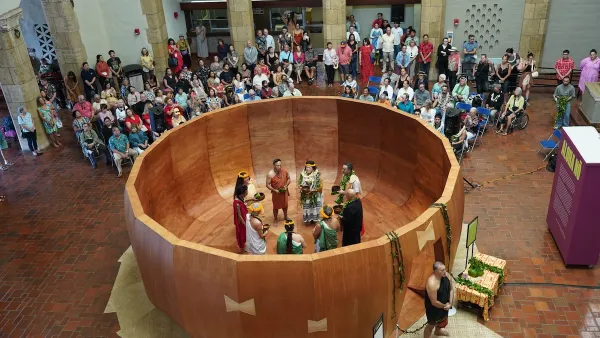Less than 25 years ago, Nantes was an old port town languishing in the wake of failing industry. But thanks to a commitment to public art, it has since become a cultural mecca and thriving tourist destination, Frank Browning reports.
Located on the westernmost shore of the Loire River, Nantes holds an important place in French history, both politically and commercially. But by the end of the 1980s, the city was in bad shape as its massive shipyards and metal factories lay empty. It was in these bleak circumstances that then-Mayor Jean-Marc Ayrault began a campaign to invest in public art that would restore to the city its economic and cultural relevance.
"First came a summer of musical and theatrical performances from groups all over Europe, intended to break the air of sadness and defeat that came from the cities' industrial decline," writes Browning. "Next, as the town moved toward plastic arts, more and more outsiders came, further boosting local confidence, leading finally to still riskier bids financed jointly by public (local, regional, national) sponsorship and corporate collaborations."
Now, the city's outdoor spaces are riddled with enormous, startling installations of contemporary art, from houses half-submerged in the river to a four-story mechanical elephant. Drawing some 200,000 tourists each summer, Nantes quite rightfully bills itself as France's most "bizarre" city. For the past 23 years, artistic director Jean Blaise has been curating works by artists from across the globe, using the city as his gallery space.
"From the beginning France's conservative UMP party... was a consistent doubter that such public investment in 'culture' could generate any real returns. So far, however, the mixture of serious art created by world-class artists, many from China and Japan, seems to have been proved a solid formula for rebirth."
FULL STORY: Art Saves a City: 5-Story Elephant Prowls the Streets

National Parks Layoffs Will Cause Communities to Lose Billions
Thousands of essential park workers were laid off this week, just before the busy spring break season.

Retro-silient?: America’s First “Eco-burb,” The Woodlands Turns 50
A master-planned community north of Houston offers lessons on green infrastructure and resilient design, but falls short of its founder’s lofty affordability and walkability goals.

Delivering for America Plan Will Downgrade Mail Service in at Least 49.5 Percent of Zip Codes
Republican and Democrat lawmakers criticize the plan for its disproportionate negative impact on rural communities.

Test News Post 1
This is a summary

Test News Headline 46
Test for the image on the front page.

Balancing Bombs and Butterflies: How the National Guard Protects a Rare Species
The National Guard at Fort Indiantown Gap uses GIS technology and land management strategies to balance military training with conservation efforts, ensuring the survival of the rare eastern regal fritillary butterfly.
Urban Design for Planners 1: Software Tools
This six-course series explores essential urban design concepts using open source software and equips planners with the tools they need to participate fully in the urban design process.
Planning for Universal Design
Learn the tools for implementing Universal Design in planning regulations.
EMC Planning Group, Inc.
Planetizen
Planetizen
Mpact (formerly Rail~Volution)
Great Falls Development Authority, Inc.
HUDs Office of Policy Development and Research
NYU Wagner Graduate School of Public Service




























